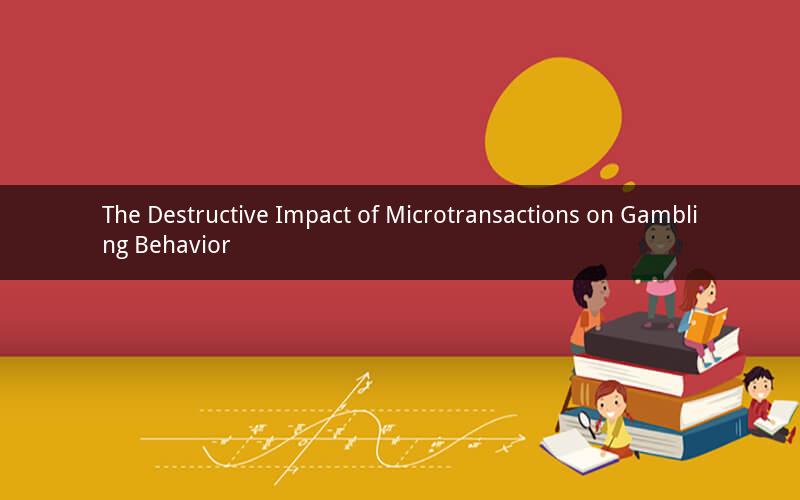
In the digital age, microtransactions have become a prevalent form of in-app purchases, allowing users to spend small amounts of money on virtual goods and services. While microtransactions are often viewed as a convenient way to enhance gaming experiences, they have also been linked to gambling problems. This article delves into how microtransactions can lead to gambling issues, highlighting the risks and consequences associated with this practice.
1. What are microtransactions?
Microtransactions refer to small, incremental purchases made within a digital platform or application. These transactions typically involve the purchase of virtual items, such as skins, in-game currency, or cosmetic enhancements. Microtransactions are designed to be easily accessible and affordable, making them appealing to a wide range of users, including children and adolescents.
2. The allure of microtransactions in gambling
The primary reason microtransactions are associated with gambling problems is their similarity to gambling mechanisms. Many microtransactions require users to engage in random chance or skill-based gameplay to obtain rewards. This creates an environment that can trigger addictive behaviors, as users may feel compelled to spend more money in the hope of achieving a desired outcome.
3. The psychological impact of microtransactions
Microtransactions can have a profound psychological impact on users, leading to gambling problems. The following factors contribute to this issue:
a. The illusion of control: Microtransactions often provide users with the perception that they have control over their gaming experience. However, the random nature of these transactions can lead to feelings of frustration and the desire to spend more money in an attempt to regain control.
b. The near-miss effect: Many microtransactions are designed to mimic slot machines, where users experience near-misses that create a sense of anticipation and excitement. This can lead to increased spending as users try to achieve the desired outcome.
c. The psychological appeal of small, manageable payments: The affordability of microtransactions can make them seem less risky and more accessible. This can lead to a gradual escalation in spending, as users become desensitized to the financial implications of their purchases.
4. The financial consequences of microtransactions
The use of microtransactions can lead to significant financial consequences, both for individuals and society as a whole. Some of the financial risks associated with microtransactions include:
a. Debt: Excessive spending on microtransactions can lead to debt, as users accumulate unpaid balances that can become difficult to manage.
b. Financial stress: The financial strain caused by microtransactions can lead to stress, anxiety, and other mental health issues.
c. Resource misallocation: The money spent on microtransactions could be allocated to more productive purposes, such as education or saving for the future.
5. The societal impact of microtransactions
The use of microtransactions has also raised concerns about their societal impact. Some of the key issues include:
a. Exploitation of vulnerable populations: Microtransactions can be particularly harmful to vulnerable populations, such as children and adolescents, who may not fully understand the financial implications of their purchases.
b. Normalization of gambling: The widespread use of microtransactions in gaming can normalize gambling behaviors, leading to a potential increase in gambling addiction and related problems.
c. Regulatory challenges: The rapid evolution of microtransactions presents significant challenges for regulators, who must develop effective policies to mitigate the risks associated with this practice.
In conclusion, microtransactions have the potential to cause gambling problems due to their similarity to gambling mechanisms and the psychological impact they can have on users. The financial and societal risks associated with microtransactions underscore the need for increased awareness and regulation in this area. By understanding the dangers of microtransactions, we can work towards creating a safer and more responsible digital environment.
Questions and Answers:
1. How can microtransactions lead to gambling problems?
Microtransactions can lead to gambling problems by mimicking gambling mechanisms, such as random chance and skill-based gameplay. This can trigger addictive behaviors, leading to excessive spending and potential financial and psychological consequences.
2. What psychological factors contribute to microtransactions causing gambling problems?
Psychological factors contributing to microtransactions causing gambling problems include the illusion of control, the near-miss effect, and the psychological appeal of small, manageable payments.
3. What are the financial consequences of microtransactions?
The financial consequences of microtransactions include debt, financial stress, and resource misallocation, as users may allocate funds to less productive purposes.
4. How can microtransactions be harmful to vulnerable populations?
Microtransactions can be harmful to vulnerable populations, such as children and adolescents, who may not fully understand the financial implications of their purchases and are more susceptible to addictive behaviors.
5. What challenges do regulators face in addressing microtransactions?
Regulators face challenges in addressing microtransactions due to their rapid evolution and the need to develop effective policies that mitigate the risks associated with this practice while preserving the gaming industry's growth.